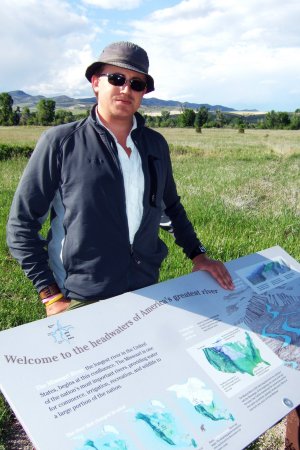 I was a hundred or so miles into a 2,341-mile canoe trip on the Missouri River when I stumbled on my first big storm. The first indication came when my hat lifted from my head and flew forward into the water. High winds came up well ahead of an advancing cold front a mile or so upriver from Fort Benton, Montana. What had been blowing before had been a breeze, but soon rose to twenty or thirty miles per hour. The filled with dust and sand, which made my teeth and tongue gritty, and my eyes burned. The temperature began to drop, and sky overhead darkened. The front moved above me. The clouds at its leading edge looked like fingers curling downward into a fist. I put on my rain jacket. The force of the storm seemed ready to descend on me, the wind roaring louder with each clap of thunder.
I was a hundred or so miles into a 2,341-mile canoe trip on the Missouri River when I stumbled on my first big storm. The first indication came when my hat lifted from my head and flew forward into the water. High winds came up well ahead of an advancing cold front a mile or so upriver from Fort Benton, Montana. What had been blowing before had been a breeze, but soon rose to twenty or thirty miles per hour. The filled with dust and sand, which made my teeth and tongue gritty, and my eyes burned. The temperature began to drop, and sky overhead darkened. The front moved above me. The clouds at its leading edge looked like fingers curling downward into a fist. I put on my rain jacket. The force of the storm seemed ready to descend on me, the wind roaring louder with each clap of thunder.
Then the rain came first as a downpour, and grew into a torrent, but I paddled on. Waves and whitecaps began to appear in the river. Troughs and crests rose in the channel that bounced the canoe up and down. I continued to paddle. Sand on the paddle’s handle ground into my hands as I dug the blade deep into the water.
I had paddled most of the day in a kind of desert, but a half-mile above Fort Benton trees began to appear on the bank; towering cottonwoods swaying in the breeze. Small saplings at the water’s edge lay flat against the ground under the force of the storm.
Then came the lightning.
A bolt zigzagged across the sky overhead, sparks bursting out of it. At the same time an explosion of thunder tore the air apart with a sound like two cars colliding head-on just inches from my ear. Seconds later, another bolt struck the ground nearby. The air sizzled, the breeze electrified by the force of the strike. The thunder exploded again, charging the molecules of the wind and the water.
On the bank I could see a man in a poncho running alongside the water’s edge. His hands waving, motioning me to the shore. Behind him, on the high bank, rows of tents fluttered and were being pressed to the ground. The area was the Fort Benton floater’s camp – my intended stopping point. Excited and fearful because of the storm, I had not been watching for it. Now it was across the river from me, separated by waves and a strong current. Turning the boat toward it, I paddled hard – trying to get across the channel before the river swept me downstream.
I saw a small inlet. The man pointed to it, and continued to wave me over with his other hand. Though the front of the boat was pointed toward the little harbor, I could feel the current pulling me away. I paddled harder than I ever had, the thunder still detonating around me like incoming mortar rounds, and the torrents of rain streaming into the collar and sleeves of my rain jacket. My paddle and I were both moving furiously trying to get back upstream. But soon my arms failed me, and I knew I had lost the fight. My arms like overheated pistons, I stopped paddling. My lungs gasped for air. The boat ramp began to get smaller in the distance.
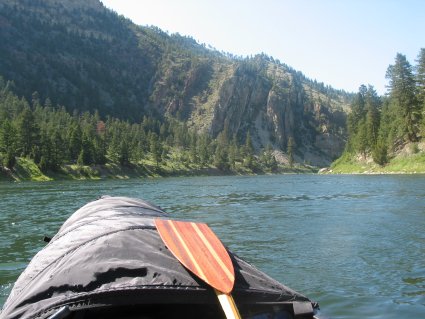
As I turned the canoe to point downstream, I saw a bridge ahead. To my left, a park ran alongside a high bank, Fort Benton’s downtown area barely visible through sheets of rain. As I paddled for the bridge a five-story brick building presented itself, a sign on its facade reading “The Grand Union Hotel.”
I paddled toward the slack water under the bridge to find protection from the rain. As the boat spun into the calm water below the bridge piling – transitioning between fast water and calm – I lost control. My weight shifted wildly as the boat leaned first to one side, then to the other. I tried to correct, but the boat lurched over. The gunwale dipped below the water and I rolled into the river as the canoe filled with water.
The canoe came to rest on the bottom in knee-deep water and ankle deep ooze. From the base of a 10-foot high rock and clay bank, I stood to steady the boat. I threw my backpack, paddle and the bowline onto the bank, and lifted the boat just far enough on the shore to dump out the water. Then I scrambled up the muddy incline, with little thought about the rest of my gear or the canoe in the turbulent water below. By the time the hail started, my backpack and I were already in the old hotel inquiring about a room.
Inside the air was dry and cool, and I shivered as I stood. The big clock in the lobby read five o’clock. Happy hour. All the adventurers who were following the Lewis and Clark route by car were gathered in clumps, sipping martinis and talking, some with books or maps spread out in front of them planning the next leg of their journey. Periodically one of them would glance outside, and motion after some comment about the storm. Some turned to look at the wet and muddy stranger that had just wandered into the hotel. Some looked interested, as though I were a sideshow curiosity. Others looked apprehensively in my direction, as though I were a dog about shake all over their evening clothes. My brown-stained red rain jacket dripped chocolate colored water on the hardwood floor of the lobby, and I returned the group’s stares with a “eh, what are ya gonna do” shrug.
Ft. Benton was a bit of a remnant from another time. With the advent of steam engines, bulky materials could be moved upriver, and soon riverboats plied the Missouri connecting developing centers of trade – Kansas City, Omaha, Sioux Falls, Pierre, Bismarck – with St. Louis.
The Grand Union Hotel had been built in 1888. At the time, Fort Benton was enjoying a brief boom as the last navigable point on the Missouri that could be reached by steamboat. Filled with salable items and trade goods, the boats would make the dangerous trip from St. Louis upriver to the settlement in about two months. All of the metals, ore and agricultural produce would travel from the farms and mines by wagon to Fort Benton, then ship to St. Louis on the riverboat’s return trip. The town had even gained a certain amount of notoriety when its boats carried wounded men of the 7th U.S. Calvary to St. Louis in 1876, along with the first news of the defeat of General George Armstrong Custer.
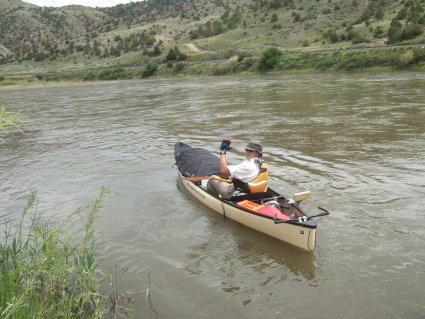
But by 1890, the same year that the U.S. Census Bureau declared the frontier closed, the transcontinental railroads began to supplant the Missouri as the highway west. As Mark Twain’s steamboat era ended, the romantic sight of steamboats plying the Missouri gradually gave way to the railroad, its efficient straight line diverting commerce far from the wild and wandering river. In the book River of Promise, River of Peril: The Politics of Managing the Missouri River, Author John E. Thorson explains that…
once thriving communities along the river are now struggling footnotes to the history of American settlement: Fort Benton, at one time the vital trade exchange between the river and the plains; Fort McKenzie, now only a state park; even Great Falls, which once considered Minneapolis as its peer, now share the decline of the mineral and agricultural industries and the military complex.
In the beginning of the 21st century the Grand Union came to personify a particular attitude toward the formerly wild parts of the United States; as quaint curiosities to the highway traveler, who would experience a few tattered remnants of the mighty west with martini in hand, admiring the river through the windows of a five-star restaurant before packing up and checking out. People wanting to go to the west to “live deliberately,” but only until about five in the evening, because that’s happy hour and check in time at the newly renovated Grand Union Hotel.
Places like The Grand Union survive as ghosts of this once promising past in these all-but-abandoned river towns. But they exist not as cosmopolitan preserves in the middle of the Wild West, but as quaint boutique operations that recreate a cushioned and sanitized version of the western experience. Only a nostalgic shell of what they once stood for; the now dull spearhead of manifest destiny.
Outside, the wind and the rain continued to howl, and after a long shower I went into the restaurant and sat down at the bar. Before me a tall mirror on the back bar reflected the rest of the room. Through a window I could see the bridge, near which sat my canoe weathering the storm alone. The boat was secured to a tree, and, I hoped, holding up against the wind and the waves. For a brief second, I experienced guilt that I had abandoned my faithful steed to the rain and the hail. But the feeling was swallowed by another; a voice reminding me that it was just boat, not a living thing with feelings.
While seated at the bar, after ordering a blood-rare steak, I sipped a glass of wine and began to catch up my journal. This time I had something more than landscape and miles to write about. I finished one glass and ordered another, the wine’s warmth coursing through my body and moving my pen. The wine lifted my soggy disposition, and the dinner dried my depression. I felt warm and happy.

After dinner I met a hydrologist with the United Stated Geologic Survey. He had been seated at the other end of the bar, and once the bartender had clearly expressed her disinterest in him, he engaged me in conversation. After discussing the river and its history for a long time, we agreed that we would shove off together in the morning. He and a small group were combining a post-semester float with an expedition into the Upper Missouri Breaks National Wilderness for some field research. I was welcome to come along, too.
His information about the Missouri Breaks- the next section of the river – surprised me. All of my research of the area touted its rugged beauty and its pristine nature. But apparently it’s so pristine that everyone wants to come see it. Therefore it’s not uncommon for the primitive camping areas to be full.
“And they don’t like you to camp outside of the camping areas, you know.” He said.
“But don’t worry,” he continued, “It’s still early in the season. With the weather being unpredictable like this…”
His sentence was interrupted by a well-timed crack of thunder.
“…most people stay away. So aside from my scientist friend, a colleague or two and a couple of grad-school minions we should have the river to ourselves.”
“Have you paddled The Breaks a lot?” I asked.
“Oh yeah,” he said, “Fifteen or twenty times. I live in Great Falls. I love to take a new girlfriend camping out here. This stretch will always clear out any inhibitions you have about being with someone. You know, with the wag-bag thing and all.”
“What’s a ‘wag-bag’ thing?” I asked.
“You don’t know about wag bags? You’d better get to the float shop tomorrow before we take off. They’re required by law. You can get fined if they catch you without ’em. Empty or full!”
He laughed loudly.
“Anything you take in, you have to bring out,” he declared. “And I do mean anything.”
He laughed again. The bartender sneered at him. I felt confused. Of course I was all about low-impact camping. What’s to laugh about? He could see I hadn’t made the connection.
“No,” he said, “I mean anything you bring in, you bring out. Whatever you produce, yellow or brown, goes in the wag bag and you have to carry it around with you until Judith Landing.”
“Oh,” I said, figuring out that he was talking about a person’s own urine and feces. My shoulders shook as I laughed and my eyes crinkled.
“That’s terrible!” I said.
“Yeah,” he replied, “but like I said. If you and a girl go through a wag-bag camping trip and you stay together, then it’s meant to be. Nothing says true love like carrying around a boatload of each others’ shit.”
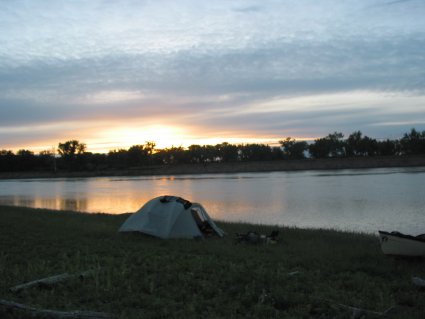
Crass though he was, I couldn’t argue with his logic. Plus, he was entertaining. I was looking forward to joining him and his team on the river for a little while. I had been alone on the river for two weeks. Some company would be a worthy distraction.
When the bar had closed, and my friend had gone to bed, I noticed a sign on the wall near the entrance to bar as I staggered toward my room. It read:
Some stout was spilled on the barroom floor
when the pub was shut down for the night.
Out of his hole crept a wee brown mouse
And he stood in the pale moonlight.
He lapped up the frothy brew from the floor
And back on his haunches he sat
And all night long you could hear him roar
“Bring on the goddamn cat!”
Thunder rumbled outside. While paddling through the storm, I had briefly entertained the idea of finding a ride back to Great Falls. The storm had rattled me, but the wine had restored my confidence.
“Bring on the goddamn cat!” I yelled down the empty stairwell.
Biography
Ryan O’Reilly, the grandson of the O’Reilly Auto Parts founder, is also the author of 2 novels, and a free-lance contributor to various newspapers and periodicals throughout the country. He studied English Literature at Westminster College in Fulton, Missouri and is a member of the National Writers Association and the Writers League of Texas. O’Reilly divides his time between his business in Austin, Texas and a small farm in Clever, Missouri.


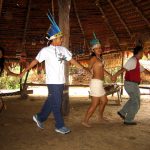
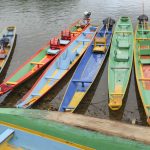

Leave a Reply